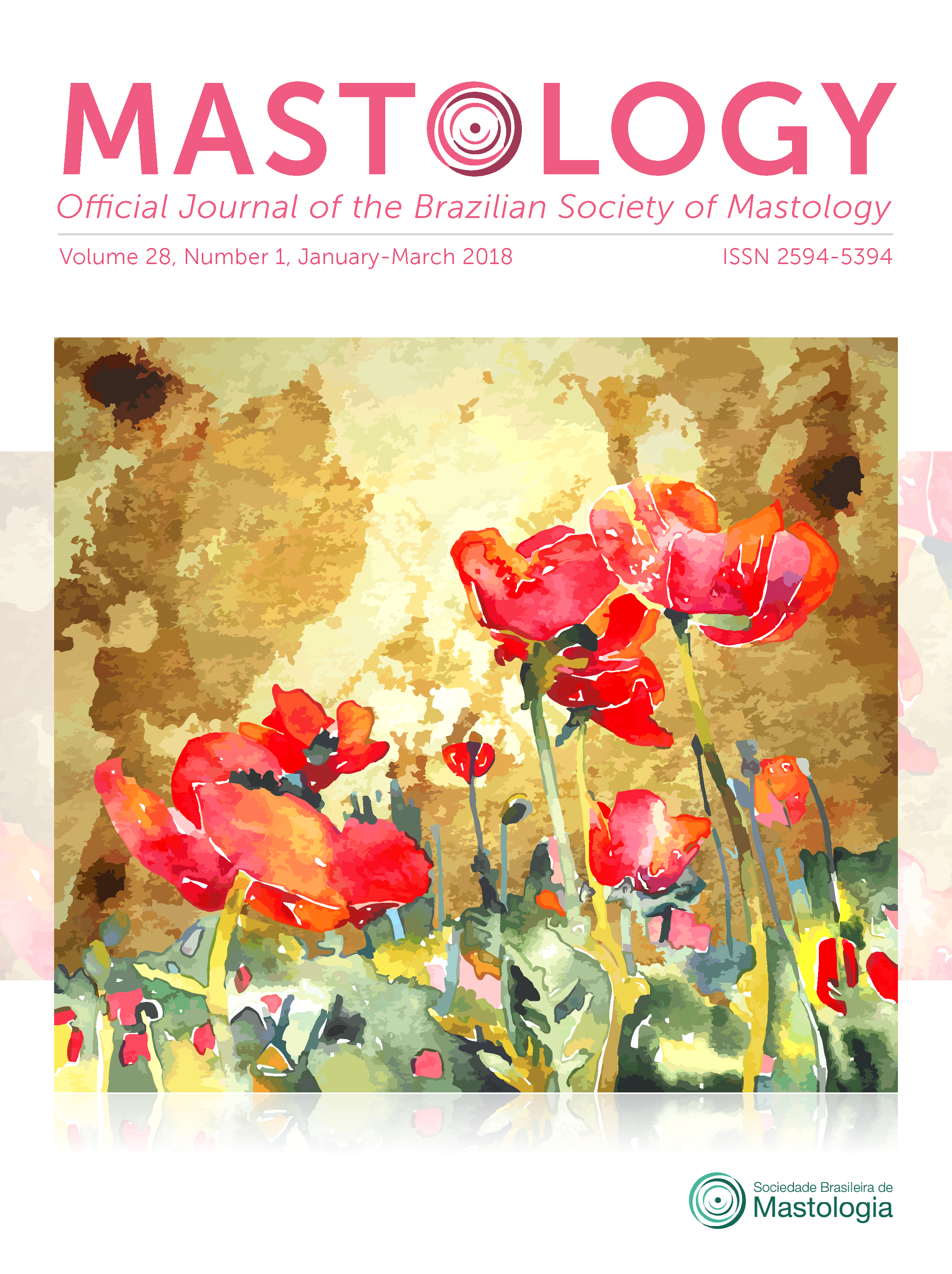Carcinomas lobulares invasores de mama tratados no Hospital de Clínicas da UFPR
incidência, características e evolução clínica
Palavras-chave:
carcinoma lobular, neoplasias da mama, histologia, carcinoma ductal, carcinoma medularResumo
Objetivo: O estudo busca caracterizar o perfil clínico epidemiológico referente às pacientes tratadas por carcinoma lobular invasor de mama (CLI) no Hospital de Clínicas da Universidade Federal do Paraná (HC-UFPR) em um período de dez anos e avaliar as variações das dimensões dos CLI nos exames de imagem quando comparadas ao real tamanho das lesões identificadas nas peças de anatomia patológica. Métodos: Foram selecionadas pacientes submetidas a procedimentos cirúrgicos de mama no HC-UFPR entre os anos de 2005 e 2014, dentre as quais 36 apresentaram diagnóstico de CLI. Seus prontuários foram analisados para avaliação de características clínicas, epidemiológicas, terapêuticas e prognósticas. Também foi avaliada a discrepância dos valores de tamanho do tumor em métodos de imagem em relação ao descrito nos laudos anatomopatológicos. Resultados: A s p acientes c om d iagnóstico d e C LI tinham média de idade no diagnóstico de 59,6 anos. O diagnóstico foi feito, em sua maioria, nos estádios clínicos II (40%) e III (26,7%). Houve maior negatividade (77,2%) para HER2 e positividade (90%) para receptor de estrógeno. O tratamento cirúrgico foi radical em 74,2% das pacientes. Em exames de imagem, 31,4% das pacientes realizaram mamografia e ultrassonografia em conjunto, 45,7% fizeram apenas um dos exames e nenhuma realizou ressonância magnética. Conclusão: Observou-se que a casuística de patologias mamárias do HC-UFPR está de acordo com a literatura em relação à incidência e às características próprias dos CLI. A análise da discrepância dos tamanhos dos tumores em exames de imagem em relação às peças cirúrgicas não obteve resultados significativos estatisticamente.
Downloads
Referências
Instituto Nacional de Cancer José Alencar Gomes da Silva. Estimativa 2016. Brasil: Ministério da Saúde; 2016.
Ferlay J, Soerjomataram I, Ervik M, Dikshit R, Eser S, Mathers C, et al. GLOBOCAN 2012 v1.0, Cancer incidence and mortality worldwide: IARC cancerbase. cancer incidence and mortality worldwide. IARC Cancer Base; 2014.
Li CI, Uribe DJ, Daling JR. Clinical characteristics of different histologic types of breast cancer. Br J Cancer. 2005;93(9):1046‑52.https://dx.doi.org/10.1038%2Fsj.bjc.6602787
Dossus L, Benusiglio PR. Lobular breast cancer: incidence and genetic and non-genetic risk factors. Breast Cancer Res. 2015;17:37. https://doi.org/10.1186/s13058-015-0546-7
Eheman CR, Shaw KM, Ryerson AB, Miller JW, Ajani UA, White MC. The changing incidence of in situ and invasive ductal and lobular breast carcinomas: United States, 1999-2004. Cancer Epidemiol Biomarkers Prev. 2009;18(6):1763-9. https://doi.org/10.1158/1055-9965.EPI-08-1082
Rossouw JE, Anderson GL, Prentice RL, LaCroix AZ, Kooperberg C, Stefanick ML, et al. Risks and Benefits of Estrogen Plus Progestin in Healthy Postmenopausal Women. J Am Med Assoc. 2012;288(3):321-33.
Wachtel MS, Yang S, Dissanaike S, Margenthaler JA. Hormone replacement therapy, likely neither angel nor demon. PLoS One. 2015;10(9):e0138556. https://doi.org/10.1371/journal.pone.0138556
Christgen M, Steinemann D, Kühnle E, Länger F, Gluz O, Harbeck N, et al. Lobular breast cancer: Clinical, molecular and morphological characteristics. Pathol Res Pract. 2016;212(7):583-97. https://doi.org/10.1016/j.prp.2016.05.002
Allen-Brady K, Camp NJ, Ward JH, Cannon-Albright LA. Lobular breast cancer: Excess familiality observed in the Utah Population Database. Int J Cancer. 2005;117(4):655-61. https://doi.org/10.1002/ijc.21236
Li CI, Daling JR, Haugen KL, Tang MTC, Porter PL, Malone KE. Use of menopausal hormone therapy and risk of ductal and lobular breast cancer among women 55-74 years of age. Breast Cancer Res Treat. 2014;145(2):481-9. https://doi.org/10.1007/s10549-014-2960-4
Newcomb PA, Trentham-Dietz A, Hampton JM, Egan KM, Titus-Ernstoff L, Warren Andersen S, et al. Late age at first full term birth is strongly associated with lobular breast cancer. Cancer. 2011;117(9):1946-56. https://dx.doi.org/10.1002%2Fcncr.25728
Li CI, Malone KE, Porter PL, Weiss NS, Tang MTC, Daling JR. Reproductive and anthropometric factors in relation to the risk of lobular and ductal breast carcinoma among women 65-79 years of age. Int J Cancer. 2003;107(4):647-51. https://doi.org/10.1002/ijc.11465
Sharma SDJ, Barry M, O’Reilly EA, Kell MR. Surgical management of lobular carcinoma from a national screening program: a retrospective analysis. Eur J Surg Oncol. 2015;41(1):79-85. https://doi.org/10.1016/j.ejso.2014.09.004
Lee J-H, Park S, Park HS, Park B-W. Clinicopathological features of infiltrating lobular carcinomas comparing with infiltrating ductal carcinomas: a case control study. World J Surg Oncol. 2010;8:34. https://doi.org/10.1186/1477-7819-8-34
Arpino G, Bardou VJ, Clark GM, Elledge RM. Infiltrating lobular carcinoma of the breast: tumor characteristics and clinical outcome. Breast Cancer Res. 2004;6(3):R149-56. https://dx.doi.org/10.1186%2Fbcr767
Sastre-Garau X, Jouve M, Asselain B, Vincent-Salomon A, Beuzeboc P, Dorval T, et al. Infiltrating lobular carcinoma of the breast: Clinicopathologic analysis of 975 cases with reference to data on conservative therapy and metastatic patterns. Cancer. 1996;77(1):113-20. https://doi.org/10.1002/(SICI)1097-0142(19960101)77:1%3C113::AIDCNCR19%3E3.0.CO;2-8
Sinclair K, Sakellariou S, Dawson N, Litherland J. Does preoperative breast MRI significantly impact on initial surgical procedure and re-operation rates in patients with screen-detected invasive lobular carcinoma? Clin Radiol. 2016;71(6):543-50. https://doi.org/10.1016/j.crad.2016.03.011
Smith DB, Howell A, Wagstaff J. Infiltrating lobular carcinoma of the breast: Response to endocrine therapy and survival. Eur J Cancer Clin Oncol. 1987;23(7):979-82.
Dutra MC, Rezende MA, de Andrade VP, Soares FA, Ribeiro MV, de Paula EC, et al. Imunofenótipo e evolução de câncer de mama: comparação entre mulheres muito jovens e mulheres na pós-menopausa. Rev Bras Ginecol Obs. 2009;31(2):54-60. http://dx.doi.org/10.1590/S0100-72032009000200002
Biglia N, Mariani L, Sgro L, Mininanni P, Moggio G, Sismondi P. Increased incidence of lobular breast cancer in women treated with hormone replacement therapy: implications for diagnosis, surgical and medical treatment. Endocr Relat Cancer. 2007;14(3):549-67. https://doi.org/10.1677/ERC-06-0060
Zhu MZ, Yu XF, He XM, Feng WL, Fan JH, Li J, et al. Clinicopathological features of invasive lobular carcinoma of the breast: a nationwide multicenter study in China. J Cancer Res Ther. 2015;11(Supl. 1):C89-94. https://doi.org/10.4103/0973-1482.163851
Winchester DJ, Chang HR, Graves TA, Menck HR, Bland KI, Winchester DP. A comparative analysis of lobular and ductal carcinoma of the breast: presentation, treatment, and outcomes. J Am Coll Surg. 1998;186(4):416-22.
Gomes, DS. Aspectos clínicos, anátomo-patológicos e evolutivos de uma série de lesões lobulares da mama tratadas em uma mesma instituição [dissertation]. Belo Horizonte: Federal University of Minas Gerais. Medicine School; 2010;
Peiro G, Bornstein BA, Connolly JL, Gelman R, Hetelekidis S, Nixon AJ, et al. The influence of infiltrating lobular carcinoma on the outcome of patients treated with breast-conserving surgery and radiation therapy. Breast Cancer Res Treat. 2000;59(1):49-54.
Dillon MF, Hill ADK, Fleming FJ, O’Doherty A, Quinn CM, McDermott EW, et al. Identifying patients at risk of compromised margins following breast conservation for lobular carcinoma. Am J Surg. 2006;191(2):201-5. https://doi.org/10.1016/j.amjsurg.2005.03.041
Salles MDA, Cúrcio VS, Perez AA, Gomes DS, Gobbi H. Contribuição da imuno-histoquímica na avaliação de fatores prognósticos e preditivos do câncer de mama e no diagnóstico de lesões mamárias. J Bras Patol e Med Lab. 2009;45(3):213-22. http://dx.doi.org/10.1590/S1676-24442009000300006
Giuliano AE, Ballman K, McCall L, Beitsch P, Whitworth PW, Blumencranz P, et al. Locoregional Recurrence After Sentinel Lymph Node Dissection With or Without Axillary Dissection in Patients With Sentinel Lymph Node Metastases. Ann Surg. 2016;264(3):413-20. https://doi.org/10.1097/SLA.0000000000001863
Rakha EA, El-Sayed ME, Powe DG, Green AR, Habashy H, Grainge MJ, et al. Invasive lobular carcinoma of the breast: response to hormonal therapy and outcomes. Eur J Cancer. 2008;44(1):73-83. https://doi.org/10.1016/j.ejca.2007.10.009
Mann RM, Hoogeveen YL, Blickman JG, Boetes C. MRI compared to conventional diagnostic work-up in the detection and evaluation of invasive lobular carcinoma of the breast: a review of existing literature. Breast Cancer Res Treat. 2008 Jan;107(1):1-14. https://dx.doi.org/10.1007%2Fs10549-007-9528-5
Yeatman TJ, Cantor AB, Smith TJ, Smith SK, Reintgen DS, Miller MS, et al. Tumor biology of infiltrating lobular carcinoma. Implications for management. Ann Surg. 1995;222(4):549-61.
Downloads
Publicado
Como Citar
Edição
Seção
Licença
Copyright (c) 2018 Anaí Caroline Hamann Gasperin, Gabriela Romaniello, Isabella Naomi Furuie, Maria Júlia Jorge Mauro, Thayane Guimarães de Melo, Plínio Gasperin Júnior, Vinicius Milani Budel

Este trabalho está licenciado sob uma licença Creative Commons Attribution 4.0 International License.







